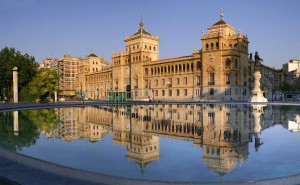Study in Valladolid, Spain
Study in Valladolid, Spain

The city of Valladolid in Spain is generally recognized as the de facto capital of the autonomous community of Castile and Leon. The municipality has a population of roughly 310,000 permanent residents as of 2014, making it Spain’s 13th-most populous city and the largest municipality in the northwest part of the country.
Valladolid is situated at the intersection of the Pisuerga and Esgueva rivers and within five prime winegrowing regions—the regions of Ribera del Duero, Rueda, Toro, Tierra de León, and Cigales. The city’s name is linked to the 8th century Moorish Caliph Al-Walid I, a Muslim leader who ruled the then Islamic Empire between 705 and 715 AD.
The “Old Town” of Valladolid is today comprised of a variety of quaint historic houses, luxurious palaces, opulent churches, and many plazas, avenues and parks. The Old Quarter is also home to the “National Museum of Sculpture,” the “Museum of Contemporary Arts Patio Herreriano (or Oriental Museum),” and the homes of the famous Jose Zorilla and Cervantes, both of which are now open to the public as museums. Among the many events that are held in Valladolid each year are its Holy Week Festival, held in the week prior to Easter Sunday; the Valladolid International Film Week (Seminici); and the Theater and Street Art Festival, known locally by the acronym “TAC.”
The former capital of Spain in ancient times, Valladolid is located in close proximity to other major Spanish cities, including Madrid, Salamanca and Leon. Loaded with authentic Spanish culture and other artistry, Valladolid is rich in history, wine and agriculture, and boasts a lively nightlife. Situated on the Castilian “meseta,” the city is both vibrant and artistic, and the perfect locale for visitors who long for an authentic taste of Spanish culture.
Things to Do and See in Valladolid
Valladolid hosts a great number of important cultural and artistic sites worth visiting. Due to its layout, visitors can see many of these sites by traveling on foot through the city’s quaint streets, discovering its many plazas and Gothic-themed structures.
Some of the more popular attractions in Valladolid include:
National Sculpture Museum (Museo Nacional de Escultura)
The National Sculpture Museum is one of the most oft-visited attractions in the city of Valladolid. Located in the beautiful San Gregorio College, the museum features a marvelous collection of Spanish sculpture, polychromatic wooden sculptures, statues, altarpieces, and even a 16th-century Gothic Pieta.
Patio Herreriano (Museum of Contemporary Spanish Art)
A very interesting and equally popular Valladolid attraction, the Museum of Contemporary Spanish Art features a collection containing some 800 pieces of contemporary Spanish art, ranging from 1918 to the present. The museum’s paintings, sculptures, and written works illuminate the very best of Spain’s modern artists and their works from the 20th and 21st centuries.
Cathedral of Valladolid (Catedral Nuestra Senora de la Asuncion)
The Cathedral of Valladolid can be found directly opposite the city’s university. Designed by famed architect Juan de Herrera, construction of the cathedral began in the 16th century; although the main façade, designed by renowned artist A. Churriguera, was not completed until the 18th century. Visitors to the cathedral can marvel at a breathtaking collection of sculpture and painting, some dating back several centuries.

